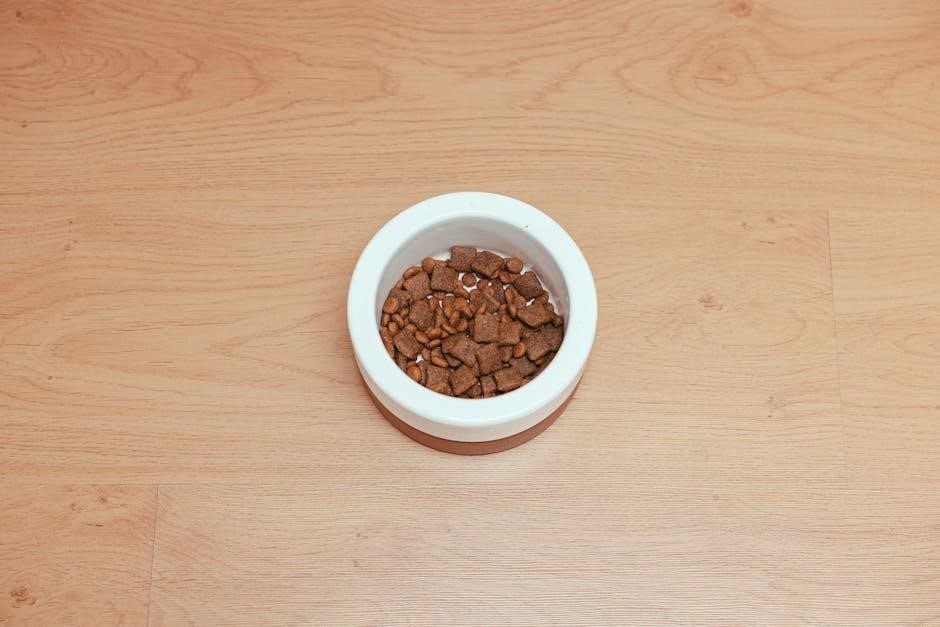Welcome to the Big Dog BARF Feeding Guide‚ your comprehensive resource for understanding the benefits and implementation of a biologically appropriate raw food diet for large breeds.
1.1 What is the BARF Diet?
The BARF (Biologically Appropriate Raw Food) diet is a feeding approach that mimics a dog’s natural diet‚ focusing on raw‚ unprocessed ingredients. It typically includes muscle meat‚ raw bones‚ fruits‚ vegetables‚ and organs‚ aiming to replicate what wild canines eat. The diet avoids grains and processed foods‚ promoting improved digestion and overall health. It’s tailored to meet a dog’s biological needs‚ ensuring essential nutrients for optimal wellness.
1.2 Importance of Protein-to-Fat Ratio in Large Breed Dogs
The protein-to-fat ratio is critical for large breed dogs to ensure proper growth and energy levels. A balanced ratio prevents obesity and supports muscle development. Typically‚ a ratio of 2:1 or 3:1 (protein to fat) is recommended. Excess fat can lead to weight gain‚ while insufficient protein may hinder muscle growth. This balance is vital for maintaining joint health and overall vitality in large breeds‚ making it a cornerstone of the BARF diet.

Benefits of the BARF Diet for Large Breeds
The BARF diet promotes optimal health for large breeds by improving digestion‚ reducing allergies‚ and enhancing coat condition. It supports cleaner teeth‚ shinier coats‚ and higher energy levels. Always consult a veterinarian for personalized advice.
2.1 Improved Digestion and Nutrient Absorption
A BARF diet aligns with a dog’s natural digestive needs‚ reducing stomach issues and enhancing nutrient uptake. Raw‚ unprocessed foods are easier for large breeds to digest‚ minimizing bloating and discomfort. This diet promotes healthier gut function‚ leading to better absorption of essential vitamins and minerals. Improved digestion often results in shinier coats‚ more energy‚ and fewer digestive disorders‚ supporting overall health and vitality.
2.2 Healthier Teeth and Gums Through Raw Bones
Raw bones play a crucial role in maintaining dental health by naturally cleaning teeth and strengthening gums. The chewing action helps remove plaque and tartar‚ reducing the risk of dental diseases. Bones also provide essential nutrients like calcium and phosphorus‚ promoting strong‚ healthy teeth. This natural process supports overall oral hygiene‚ preventing bad breath and gum inflammation‚ while keeping your dog’s smile bright and their mouth healthy.
2.3 Reduced Allergies and Skin Issues
The BARF diet often leads to reduced allergies and skin problems in large breeds. By eliminating common allergens like grains and fillers found in processed foods‚ dogs experience fewer irritations. Raw diets promote healthier skin and coat conditions‚ minimizing inflammation and allergic reactions. This natural approach supports the immune system‚ leading to improved overall skin health and reduced scratching or itching in big dogs.

Risks and Considerations of the BARF Diet
The BARF diet carries risks‚ including potential bacterial contamination and nutritional imbalances. Proper sourcing‚ handling‚ and balance are crucial to ensure safety and avoid health complications in dogs.
3.1 Potential for Nutritional Deficiencies
Nutritional deficiencies can arise in a BARF diet if meals are improperly balanced. Without sufficient variety‚ dogs may lack essential vitamins and minerals‚ such as calcium or phosphorus‚ crucial for bone health. Organ meats and vegetables must be included to prevent deficiencies in iron‚ zinc‚ and vitamins A and E. Regular veterinary check-ups are vital to ensure optimal health and address any emerging issues early.
3.2 Bacterial Contamination Risks
A BARF diet poses bacterial contamination risks‚ including Salmonella and E. coli‚ which can harm dogs and humans. Proper handling‚ storage‚ and freezing of raw ingredients can minimize these risks. Safe food handling practices are essential to protect both your dog and family from potential health issues.
3.4 Transitioning Safely to Avoid Stomach Upsets
Transitioning your big dog to a BARF diet requires a gradual approach to avoid stomach upsets. Start by mixing small amounts of raw food with their current diet and slowly increase the proportion over 2 weeks. Monitor your dog’s behavior‚ appetite‚ and stool quality. If any digestive issues arise‚ pause the transition or consult a veterinarian. This careful process ensures a smooth adjustment and minimizes the risk of adverse reactions.

Essential Components of a BARF Diet
A BARF diet for big dogs consists of muscle meat‚ raw edible bones‚ vegetables‚ fruits‚ and organs‚ ensuring a balanced and biologically appropriate nutrition for optimal health.
4.1 Muscle Meat (70% of the Diet)
Muscle meat forms the foundation of a BARF diet‚ comprising 70% of the total intake. It provides essential proteins and amino acids for muscle growth and energy. Lean meats like beef‚ chicken‚ or turkey are commonly used‚ ensuring a natural source of moisture and nutrients. This high-protein component supports overall health and vitality in large breeds‚ making it a critical part of their balanced nutrition.
4.2 Raw Edible Bones (10% of the Diet)
Raw edible bones make up 10% of the BARF diet‚ serving multiple purposes. They provide essential calcium and phosphorus for bone health while naturally cleaning teeth and reducing tartar. Bones also satisfy a dog’s instinctual need to chew‚ keeping them entertained and mentally stimulated. Marrow bones and knucklebones are popular choices‚ offering both nutrition and satisfaction for large breeds‚ promoting overall dental and digestive well-being.
4.3 Vegetables and Fruit (10% of the Diet)
Vegetables and fruits make up 10% of the BARF diet‚ adding fiber‚ vitamins‚ and antioxidants. They support healthy digestion and overall well-being. Common choices include leafy greens like kale‚ carrots‚ apples‚ and squash. These ingredients should be finely chopped or pureed to aid digestion and ensure your big dog can absorb the nutrients effectively‚ complementing the raw meat and bones for a balanced diet.
4.4 Liver and Other Organs (5% of the Diet)
Liver and other organs‚ such as kidneys and spleen‚ are crucial in a BARF diet‚ comprising 5% of the total intake. These organs are rich in essential nutrients like iron‚ zinc‚ and vitamins‚ which are vital for healthy organ function and overall well-being. Feeding small portions ensures a balanced diet without overwhelming your dog with excess nutrients‚ maintaining optimal health for large breeds. Always source organs fresh and from reputable suppliers.

Transitioning Your Big Dog to a BARF Diet
Transitioning your big dog to a BARF diet requires patience and gradual changes to prevent digestive upset. Start with small amounts of raw food mixed with their current diet‚ slowly increasing the proportion over two weeks. Monitor their health and adjust the pace as needed to ensure a smooth and healthy transition.
Begin by mixing a small portion of raw food with your dog’s current diet‚ gradually increasing the ratio over 14 days. This minimizes stomach upsets and allows your dog to adapt to the new diet. Start with 25% raw food on day one‚ increasing by 25% every few days until reaching 100% raw by day 14. Monitor for signs of digestive discomfort and adjust the pace if needed.
5.2 Feeding Guidelines for Adult Dogs
Adult dogs on a BARF diet should be fed 2-3% of their body weight daily‚ divided into 1-2 meals. Maintain a 70-20-10 ratio: 70% muscle meat‚ 20% raw edible bones‚ and 10% organs; Adjust portions based on activity level and weight management. Ensure a variety of protein sources and organs to meet nutritional needs. Always prioritize fresh‚ high-quality ingredients for optimal health.
5.3 Special Considerations for Puppies
Puppies require a high-calorie‚ nutrient-rich diet to support rapid growth. Feed 3-4% of their body weight daily‚ divided into 3-4 meals. Emphasize balanced protein sources and include a variety of organs for essential vitamins. Introduce raw bones gradually to avoid digestive upset. Monitor growth closely and adjust portions to prevent overfeeding. Consult a veterinarian to ensure proper development and avoid deficiencies in critical nutrients like calcium and phosphorus.
5.4 Monitoring for Stomach Upsets
When transitioning to a BARF diet‚ closely monitor your dog for signs of stomach upset‚ such as diarrhea‚ vomiting‚ or lethargy. A slow introduction over 2 weeks minimizes risks. If issues arise‚ pause the transition or simplify the diet temporarily. Ensure fresh water is always available and consult a veterinarian if symptoms persist. Adjust portion sizes and ingredients to maintain digestive balance and overall health.

Key Nutrients and Supplements
Essential nutrients include calcium for bone health‚ phosphorus for balance‚ and calories tailored to large breeds. Supplements may be needed‚ but whole foods often provide adequate nutrition when properly balanced.
6.1 Role of Calcium in Bone Health
Calcium is crucial for maintaining strong bones and teeth in large breed dogs. It supports skeletal development and density‚ preventing conditions like hip dysplasia. Raw edible bones‚ a key component of the BARF diet‚ naturally provide calcium. Ensuring adequate calcium intake is vital‚ as deficiencies can lead to growth issues and long-term health problems. Proper balance with phosphorus is also essential for optimal bone health and overall well-being.
6.2 Importance of Phosphorus Balance
Phosphorus is essential for energy production‚ nerve function‚ and bone health in large breed dogs. It must be balanced with calcium to prevent developmental issues. Excess phosphorus can lead to kidney strain‚ while deficiencies impair bone mineralization. Raw bones in the BARF diet provide natural phosphorus‚ but careful portioning is vital to maintain optimal ratios and support long-term skeletal health in growing dogs.
6.3 Managing Calories for Large Breeds
Calorie management is crucial for large breeds to prevent obesity and joint strain. A BARF diet should balance protein and fat ratios while ensuring adequate energy levels. Overfeeding can lead to weight gain‚ so portion sizes must align with the dog’s activity level and weight. Regular monitoring of weight and body condition ensures optimal calorie intake‚ supporting overall health and mobility in big dogs. Avoid excessive treats to maintain this balance.

Common Mistakes to Avoid
Common mistakes include not adding calcium‚ incorrect portion sizes‚ and overlooking organ meats. These errors can lead to nutritional imbalances‚ affecting your dog’s overall health and well-being.
7.1 Not Adding Calcium to Homemade Diets
A common mistake in homemade BARF diets is not adding calcium‚ essential for bone health. Large breeds require adequate calcium to prevent issues like weak bones or fractures. Without it‚ dogs may face growth problems or long-term skeletal damage. Always include raw bones or calcium supplements to meet this critical nutritional need and ensure proper bone development in your big dog.
7.2 Incorrect Portion Sizes
Feeding incorrect portion sizes is a common error in BARF diets. Overfeeding or underfeeding can lead to weight issues‚ with large breeds being particularly vulnerable. Ensure meals are balanced and proportionate to your dog’s weight and activity level. A common mistake is miscalculating calories‚ risking starvation or obesity. Always use a measured approach and consult a vet to tailor portions for optimal health and energy levels.
7.3 Overlooking the Importance of Organ Meats
Organ meats‚ such as liver‚ are often underestimated in BARF diets. They provide essential vitamins and minerals‚ like iron and zinc‚ crucial for overall health. Omitting them can lead to nutritional deficiencies over time. Include a variety of organs (e.g.‚ liver‚ kidneys) to ensure a balanced diet. Aim for 5% of the total diet to come from organ meats for optimal health benefits and to prevent long-term health issues. Neglecting this can harm your dog’s well-being.
BARF Feeding Guide for Puppies
Nourishing your puppy with a BARF diet requires careful attention to their growth needs. Focus on high-protein‚ nutrient-rich ingredients to support development. Transition gradually from kibble to prevent digestive upset. Consult a vet to ensure proper balance and avoid deficiencies. A well-planned raw diet can promote healthy growth and long-term vitality for your puppy.
8.1 Nutritional Needs for Growth
Puppies require a diet rich in protein‚ calcium‚ and phosphorus to support rapid growth and bone development. A BARF diet should include high-quality muscle meat‚ raw bones‚ and small amounts of organ meats like liver. Ensure a balanced ratio of 1.5:1 (calcium to phosphorus) to prevent growth issues. Puppies need 1.5 to 2 times more food per pound of body weight than adult dogs‚ focusing on nutrient-dense ingredients to fuel healthy development. Consult a vet to avoid over-supplementation.
8.2 Transitioning Puppies from Kibble
Transitioning puppies from kibble to a BARF diet requires patience and careful planning. Start by mixing small amounts of raw food with their current kibble‚ gradually increasing the raw portion over 1-2 weeks. Monitor their stool quality and energy levels to avoid digestive upset. If issues arise‚ slow the transition. Ensure the raw diet is nutritionally balanced to meet growth needs‚ possibly with vet guidance.
8.3 Feeding Schedule for Puppies
Puppies require a consistent feeding schedule to support rapid growth. Feed 3-4% of their body weight daily‚ divided into 3-4 meals until 6 months old. Gradually reduce to twice daily as they mature. Monitor weight and adjust portions to prevent overfeeding. Ensure meals are balanced‚ with appropriate calcium and phosphorus levels. Consult a vet to tailor the schedule for your puppy’s specific needs and breed size.
The Big Dog BARF Feeding Guide provides a balanced approach to raw feeding‚ emphasizing protein-to-fat ratios‚ calcium intake‚ and avoiding common mistakes. Always consult a vet and do further research to ensure the best for your dog.
9.1 Final Thoughts on BARF Feeding
BARF feeding offers a natural‚ nutrient-rich diet for big dogs‚ promoting healthy digestion‚ teeth‚ and skin. While it requires careful planning‚ the benefits often outweigh the challenges. Always prioritize calcium intake‚ avoid common mistakes‚ and consult a vet. With proper research and execution‚ BARF feeding can be a transformative choice for your dog’s long-term health and well-being.
9.2 Encouragement to Do Further Research
While this guide provides a solid foundation‚ further research is essential to tailor the BARF diet to your dog’s unique needs. Explore reputable sources‚ consult veterinarians‚ and stay updated on the latest studies. Understanding the nuances of raw feeding will empower you to make informed decisions‚ ensuring your dog thrives on this natural diet.



